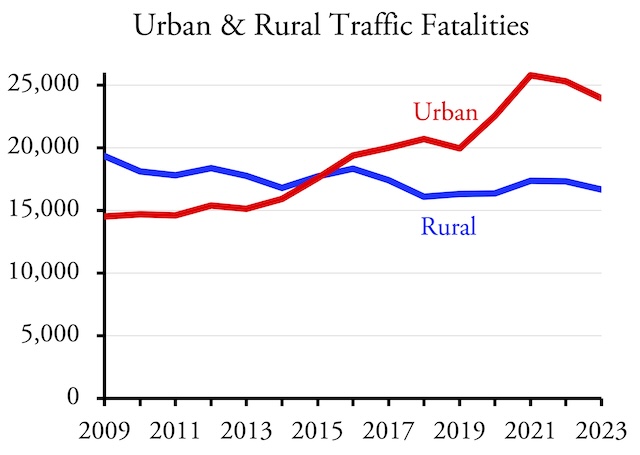A CBS Sunday Morning report promoted driverless cars as a way of improving highway safety. I’ve been saying the same thing for years, but I was surprised when the report opened with the statement, “Every year, 1.2 million people die in car accidents.” Technically, that’s true, but only 3.6 percent of them are in the United States.
According to Wikipedia (which is probably the source of the 1.2 million number), China sees 250,000 traffic fatalities per year. India is number two at more than 155,000. Despite the fact that all of Africa has only about 30 percent as many vehicles as the United States, Africa suffers 322,000 fatalities per year, with particularly high numbers in the Congo, Ethiopia, and Nigeria. Other counties with high fatalities include Brazil, Indonesia, Pakistan, Thailand, and Viet Nam.
Estimates of vehicle-kilometers traveled aren’t available for most of these countries, but fatalities per million vehicles are stunningly high in many of these countries. While the United States had just 0.15 fatalities per million vehicles in 2022, many African countries see between 20 and 70, and several Asian countries are around 4 to 9.
When compared with European countries, however, 0.15 is nothing to brag about, as Czechia, Denmark, Finland, France, Spain, Sweden, Switzerland, and the United Kingdom are all less than half of that. We do have vehicle-kilometers of travel for many European countries, and most have fatalities per billion vehicle kilometers that are about half those of the United States: the U.S. had about 8.2 fatalities per billion vehicle kilometers compared with an average of 4.4 in a dozen European countries.
Why are fatality rates so much higher in the U.S. than in Europe? No one knows exactly, but many blame the problem on the bigger cars, pickups, and SUVs that we drive. That may play a role, but other factors may be involved as well. The recent rise in U.S. pedestrian fatalities is largely due to increased homelessness. Europe may also have lower motorcycle fatalities as every European country mandates use of a helmet while many U.S. states do not. Distracted driving is a problem in both the U.S. and Europe, but may be worse in the U.S. as we don’t have good data in either area.
The good news is that U.S. fatalities and fatality rates are both declining. Last month, the National Highway Traffic Safety Administration released early estimates of 2024 fatalities, which dropped for the third straight year despite increases in driving in each of those years. Despite these drops, 2024 fatalities were still higher than in any year from 2008 to 2020.
The U.S. enjoyed a more-or-less steady decline in fatalities from 1973 (when more than 55,000 people were killed) until 2011 (when fewer than 33,000 were killed), and a decline in fatality rates from 1900 (when about 360 people died per billion vehicle miles) to 2014 (when it was less than 11). However, fatalities and rates rose until 2018, dropped slightly in 2019, then zoomed up during the pandemic, peaking at nearly 43,000 (close to 14 per billion vehicle miles) in 2021.
No one really knows why fatalities rose after 2011 (and rates rose after 2014), nor why both rose during the pandemic. Given the rise of smart phones, it seems reasonable that distracted driving was the cause of the first increase, but we can’t be sure.
One interesting thing is that the post-2011 rise was all in urban areas. Between 2009 and 2023, rural fatalities dropped by 14 percent while urban fatalities rose by 65 percent. We don’t have a breakdown of 2024 numbers by urban and rural, but urban fatalities declined in both 2022 and 2023, so it seems likely that they dropped in 2024 as well.
Self-driving cars are going to make roads safer, but it will be several more years before people can buy totally driverless cars. Until then, we need better data on what roads are most dangerous (they tend to be non-freeway arterials), what vehicles are most dangerous (it doesn’t include all SUVs), and what can be done to make them safer. We know that trying to get people to stop driving doesn’t work, but there is a lot more we can do to make driving safer.









Like everything AI, self-driving cars using AI will be the future of surface transportation. But … it will take a long time to replace the 283 million registered vehicles (average age 12.6 years) currently on US streets and highways.
If nothing else, it will give the popular press plenty to write about.
From MotorTrend
Self-Driving Cars in 2025: Where We Are Right Now According to Ride AI
Key considerations for autonomous vehicle development in 2025.
https://www.motortrend.com/news/ride-ai-2025-autonomous-driving-conference-report
The US does not have traffic calming. That’s why.
https://youtu.be/bAxRYrpbnuA?si=Gt_j4vymXOdT8Mf7
The US is built to make you drive fast from point A to point B. Americans do not care about safe streets. The goal of urban planners and traffic engineers in many european cities is to create outdoor living rooms, where people and more importantly children can roam in the streets and enjoy life, car free. There is no city like Utrecht NL in the US. Even NYC is infested with cars. It is loud and dangerous. It’s the opposite of a city like Utrecht, which is designed for humans, not for fast pod travel.
Robo cars fail Wile E coyote test.
https://m.youtube.com/watch?v=u1nRvEh9NV4
Stroads are bad. Even the Federal Highway Administration knows it. So now what? Now we look at our local stroads and decide: Should this be a street, or should it be a road? To Auto drivers, it’s a death race. Non-freeway arterial roads, stroads, which typically carry large volumes of traffic at high speeds, are the most dangerous for people on foot, accounting for 60% of all fatalities in US. But as the Antiplanner aruged 6. in his Mobility principles. Segregation of use.
Segregation of Use is the problem. Without sidewalks/crosswalks and contemporary zoning practices that segregate retail from housing, it’s extremely dangerous to leave suburban enclaves just for a gallon of milk.
“HIGHWAY FATALITIES ” don’t mean anything they were never majority automobile related or pedestrian related fatalities. The sizeable portion of traffic deaths are at urban streets/roads mainly near intersections. 2nd biggest locale is moderate speed non highway arterial aka Stroads. The stroad was invented because once towns and cities abandoned grid street layout for Suburban enclaves auto use became not only predominant but necessary and concentrated. Stroads came into being because single access roads connected to neighborhoods with no other way out. Speed limits had rise to accommodate that influx. Combined single use retail stores and drive thru restaurants.
By contrast even Europeans with cars will walk to destinations 70% of the time for trips less than 1 mile.
Americans won’t bike even a bike that costs 99 dollars. But entire industry Peloton of simulated biking in your home for a machine that costs 1900….. and sold 2.4 million units for a bike that goes nowhere.
Wanna curb traffic fatalities, screw the megaprojects, or stupid transit. Just install ten million bollards.
https://x.com/WorldBollard/status/1904618516948398519
I mostly agree, Americans are forced to live a life behind walls, because their urban/suburban environment is so hostile towards pedestrians (esp. children)/ cyclists. But why screw transit? Unlike the private automobile, transit especially rail transit is highly compatible with the outdoor living room city.
Systematicvisionary wrote, “Unlike the private automobile, transit especially rail transit is highly compatible with the outdoor living room city.”
You’ve never lived next to a rail line — especially one that runs all night. Aside from being more convenient, cars are very quiet. Rail is not.
And then there’s the problem of walking home from the rail transit trip to the grocery store in the rain or snow with three kids and a half-dozen bags of groceries.
“Cars are very quiet” You’ve clearly never lived near a highway or busy road if you think they are. There’s a reason sound barriers are installed along highways, and it’s not for their aesthetic appeal.
Living room city? Who wants transit and all its characters going through their living room? Sounds like another follower of the religion of density.
I rather have LRT running through my living room every 15 minutes than a highway, which creates a constant safety and noise hazard. In fact, your surrounding environment is so hostile towards pedestrians you have to shelter yourself in your single family home and drive everywhere with your car. There is no other option for you.
I do not want LRT or other pedestrians traveling through my living room. We tend to enjoy the right to exclude others including the general public from our homes in this country.
Whether you hear highway traffic has a lot to do with elevation and intervening flora and other structure between you and the highway. I’m nearly 2 miles from the nearest highway and don’t hear any of it from my detached SFH. Because I live in a detached house instead of the hamster-style housing you promote, I also enjoy peace and quite from the neighbors.
Why are you so concerned about the housing preference of people in countries other than your own? It’s a bit arrogant for you to be imposing your preferences on the rest of the world. Enjoy your own housing preferences, we will enjoy ours!
Sketter wrote, “You’ve clearly never lived near a highway or busy road if you think they are.”
I asked AI, “how much of the USA land area is next to or near a highway?”
The short answer, “1 percent.”
“Less than 1 percent of the land area of the U.S. is covered by roads1. The total land area of the contiguous 48 states is 2,959,067 square miles (excluding Alaska and Hawaii)1. There are approximately 24 acres covered by U.S. highways per mile or highway length2.”
Railroads are pretty noisy too … as are shopping centers, playgrounds and thunder storms.
Your math is nonsense, because it does not account for the distribution of the population. Many Americans are living next to a highway and many more are living next to busy roads. You may not notice it in your cul-de-sac suburb, because the only way out is by car and cars are not noisy…inside. You don’t notice how much you pollute the environment with your noisy car. Actually playgrounds are pretty calm compared to a busy road. Railroads are only loud in curves, otherwise they are very quite. Railroads can be designed to only have curves outside of urban areas. Shopping centers aren’t as loud as busy roads either. The quitest modes of transportation are walking and cycling. The airplane is the loudest, the car comes second. The problem is you don’t realize how loud your car is from inside and how calm a car-free city is.
Systematicvisionary is assuming facts not in evidence as they say on Perry Mason reruns …
I used to live 1,131 feet from a busy interstate highway (a three-digit one that circled a midwest US city). No noise problems — even with the windows open. But it sure got me downtown fast.
I currently live 4,742 feet from a C&O East-West rail line (freight only) near the same midwest US city. No noise problems. It’s a little annoying when I have to wait for a train to clear a crossing when I’m late for work.
And amazing … the last un-developed single-family zoned empty lots are filling up with single-family homes that are selling quite well. Homes that back up to the rail line.
All distance measurements from Google Maps.
Personal anecdotes aren’t facts. You probably do not even remember a quite place, since you are so used to car noise. A highway that is 1000 feet away usually has a noise level of 60 dBA. That’s the equivalent of standing close to a lawnmower. That’s hardly not a noise problem. That said, living on a street that has much traffic is like hell. It doesn’t create an outdoor living room atmosphere, where people and especially children can hang around, walk, bike and relax. Most rail lines aren’t creating constant noises like roads, which is why people have less problems living next to a rail line as compared to living next to a busy road.
“The recent rise in U.S. pedestrian fatalities is largely due to increased homelessness”
Source?
Readers may find this interesting and possibly useful …
Highway Traffic Noise
Understanding highway traffic noise sources and how to abate them and addressing health concerns and environmental protection legislation and regulations.
https://acousticstoday.org/wp-content/uploads/2016/12/Highway-Noise.pdf
Cities aren’t loud cars are
https://youtu.be/CTV-wwszGw8?si=5omGuBiAwmnhem5C
Cities are loud – the denser, the noisier. In addition to the noise they frequently have higher crime rates, lower school ratings, more homeless problems, less housing for the money, and a host of other negatives. I have no issue with denserati wanting to live in dense areas. The problem comes from when they want to impose density on everyone else. People on the whole do not like density beyond a certain threshold and populations tend to disperse away from it.
Who is the “your” you are referring to?